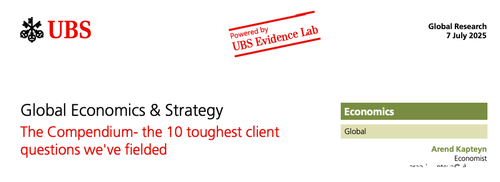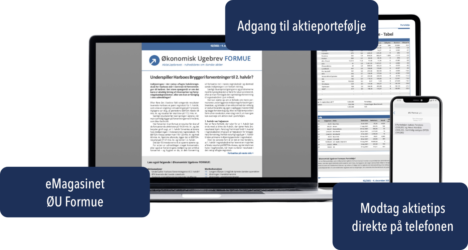Få fri adgang til alle lukkede artikler på ugebrev.dk hele sommerferien:
Tilmeld dig tre udgaver gratis af aktieanalysepublikationen ØU Formue, der udkommer igen til august
Uddrag fra UBS:
UBS strategists on Monday released a new research note addressing ten of the most pressing questions from clients, covering a wide range of critical macro themes—from tariffs, dollar dynamics, and inflation trends to the U.S. fiscal outlook, global yields, President Trump’s “One Big Beautiful Bill,” China’s stimulus-response, and the evolving global equity landscape.
The team of analysts, led by Arend Kapteyn, compiled responses to the most pressing macro and market concerns facing clients.
Below is a digest of the key insights shaping global asset allocation this summer:
1. How are tariffs impacting global growth?
The tariffs currently in place equate to about a 1 ½ % GDP tax on U.S. importers and, even with trade deals, it is not obvious tariffs are moving lower. Global hard and soft data diverged sharply in April (to a 27 year high gap), following the tariff announcements, but started to converge in May as the hard data was deteriorating faster than soft data was improving. Our global growth tracking estimate is now running at just 1.3% annualized – the 8th lowest historical percentile. Leading indicators in the U.S. look worse than the headline, whereas Europe looks surprisingly resilient, despite its openness and exposure to trade.
2. How will this dollar selloff be different from prior ones?
UBS is bearish on the dollar on the cyclical horizon, but we don’t see this as the beginning of a long-term trend of dollar depreciation. The dollar is more vulnerable relative to history looking through an NIIP lens and considering at the total amount of unhedged exposure global investors have built up. However, the current dollar selloff doesn’t possess the sine qua non of extended dollar downcycles of the past – an improvement in growth in the rest of the world and a reduction in risk premia. This will limit the scope and length of this dollar depreciation cycle.
3. Why can’t we see the tariffs in the U.S. inflation data?
Initial tariff effects have started to appear in some private sector data, but the setup of the tariffs, firm inventories, and CPI methodology all lead to a delayed pass-through into the official consumer price measures. We expect it will be the July CPI (released in August) before tariffs have a notable impact on the main inflation aggregates, and it is certainly possible that it could be a month or two later.
4. How are exporters (globally) responding to U.S. tariffs?
Front-running of tariffs, both in Q1 and possibly even partly in April/May, suggests we have not yet reached the steady state where volumes have adjusted lower to higher prices. There are also large gaps between the U.S. and China reported data, and between container shipping data and officially reported trade. However, there is virtually no evidence that foreign exporters have absorbed tariffs by lowering export prices. They did possibly absorb the USD depreciation impact on their profits. We also see no clear signs of transshipment, but it is still early days.
5. Is the U.S. fiscal outlook pushing global yields higher?
The vast majority of the changes in the budget deficit come from the extension of the 2017 tax cuts, which already seemed likely immediately after the election. The recent news has not fundamentally changed the deficit outlook from that immediately after the election snapshot.We are very worried about supply over a longer horizon. But historically swings in demand tend to be much larger than swings in supply. If concern about an economic slowdown continues to rise, then domestic demand for Tsys should rise enough to easily absorb this supply
6. What is the evidence of rotation away from the U.S.?
The notion that foreign investors are reducing their exposure to U.S. assets has become widely shared among market participants. April US TIC data provided evidence of selling of U.S. assets, but it is less clear whether the rotation continued beyond April. The fact that the USD continued nonetheless to sell off points to FX hedging as a likely driving force; further weakening of the U.S. economy and lower U.S. rates would in our view catalyze further FX hedging of U.S. asset holdings. Meanwhile, we thus far see no clear evidence in M&A announcement data to validate the Administration’s assertion of over $10tn in FDI investment commitments into the U.S.
7. How exceptional is the U.S. equity market compared to Europe?
The U.S. normally outperforms when global GDP slows for many good reasons but this time around the GDP slowdown is U.S. centric (with EZ surprises holding up much better than the U.S. and this not being fully reflected in performance). The U.S. normally outperforms if tech outperforms but we are a lot more selective on tech. What is exceptionally bad in the U.S. v EZ? Valuation (abnormally expensive v EU); fiscal position and household excess savings.What is no longer exceptional in the U.S. v EZ?: Buybacks (as % of market cap) and GDP growth (which is marginally below that of the EU in 2026). What is more attractive in the U.S. than EZ? Productivity growth relative to EZ but there are some signs of change.
8. Does the One Big Beautiful bill help, or hurt, U.S. growth?
The One Big Beautiful Bill Act adds to deficits through 2026, then flips to narrowing, in sum reducing deficits by $0.4 trillion over 10 years, according to the CBO. Weighing the parts, we expect OBBBA adds ~45 bp to growth through 2026E before fiscal drag sets in.
9. How are central banks responding to the global tariff escalation?
The lack of retaliation and the dollar’s depreciation have shifted central banks’ views. Both our own analysts and the market have added about 1-3 policy rate cuts since April 2nd. The state of the world we are in is a much simpler one than the stagflationary version most central banks feared prior to Liberation day. The tariff shock is now predominantly a growth shock, and central banks can add easing. The Fed, by contrast, is stuck between both sides of its mandate, and appears to want to prioritize the labour market, despite the inflation delta being larger. Our Deep Speak model suggests that, out of the G3, ECB sentiment has shifted move dovishly, and that the BoJ is starting to worry about growth.
10. How much stimulus has China implemented, and how much more is coming?
China announced a 1.5-2% of GDP broad fiscal stimulus, set a monetary easing tone (UBSe: 30-40bp policy rate cut), and emphasized supporting consumption for 2025 at its March NPC. The PBC cut its policy rate by 10bp in May and pushed up credit growth modestly in H1. China front-loaded its government bond issuance, and we estimate its AFD expanded by 1.1% of GDP in H1. China’s GDP growth remained robust in H1 while it may face more headwinds ahead, leading to data-dependent additional policy support. In H2, we expect another 20-30bp policy rate cut, delivery of the remaining planned fiscal stimulus (0.5-1%), and additional fiscal stimulus by >0.5% of GDP (possibly around end-Q3).
UBS’s latest research compendium offers a clear snapshot of the evolving macroeconomic landscape as the second half of 2025 begins
Intro-pris i 3 måneder
Få unik indsigt i de vigtigste erhvervsbegivenheder og dybdegående analyser, så du som investor, rådgiver og topleder kan handle proaktivt og kapitalisere på ændringer.
- Fuld adgang til ugebrev.dk
- Nyhedsmails med daglige opdateringer
- Ingen binding
199 kr./måned
Normalpris 349 kr./måned
199 kr./md. de første tre måneder,
herefter 349 kr./md.
Allerede abonnent? Log ind her








